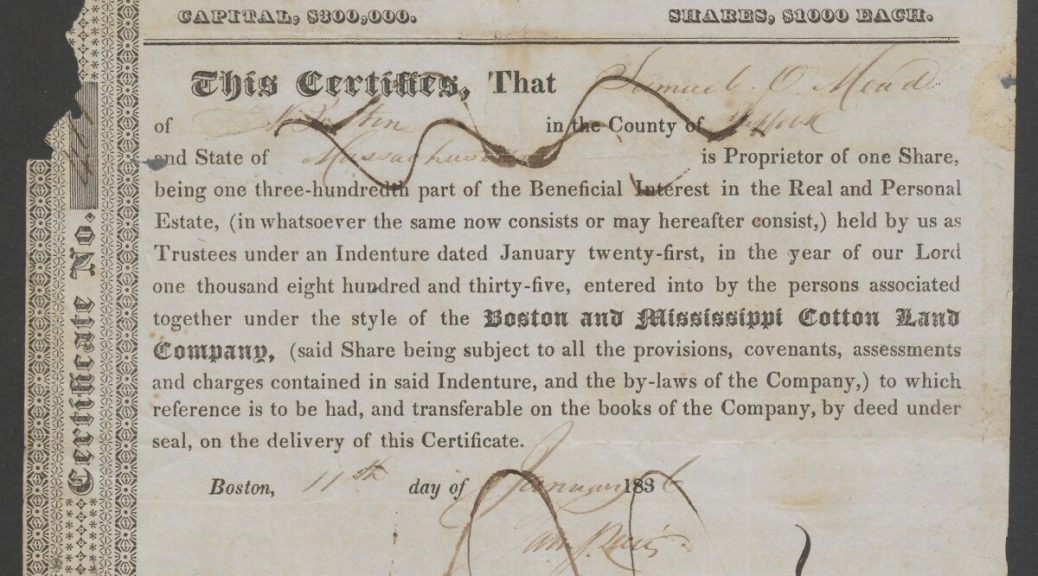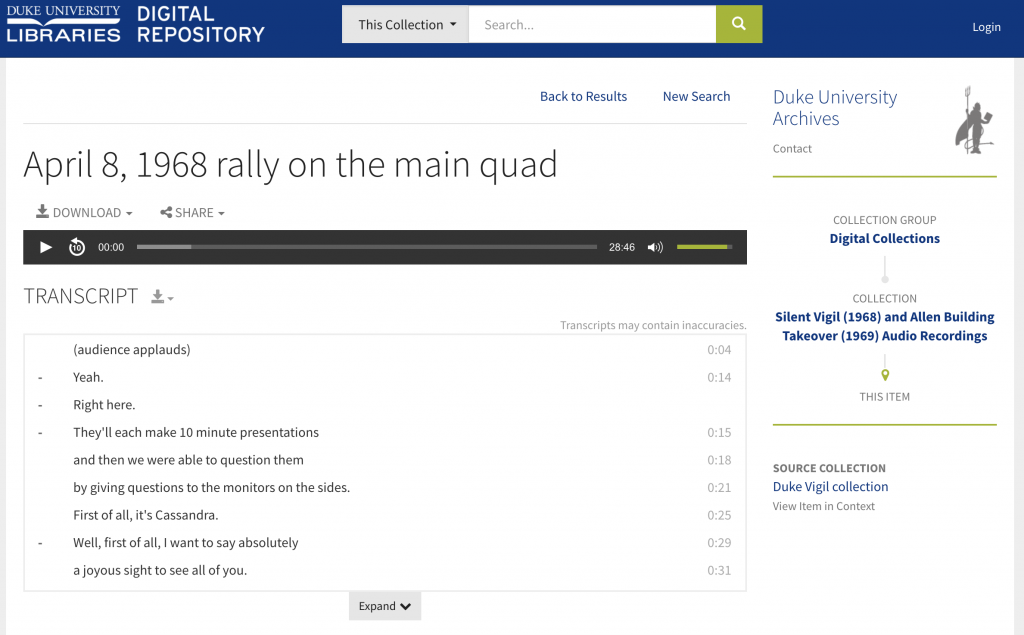2017 has been an action packed year for Digital Collections full of exciting projects, interface developments and new processes and procedures. This blog post is an attempt to summarize just a few of our favorite accomplishments from the last year. Digital Collections is truly a group cross-departmental collaboration here at Duke, and we couldn’t do complete any of the work listed below without all our colleagues across the library – thanks to all!
New Digital Collections Portal
Regular visitors to Duke Digital Collections may have noticed that our old portal (library.duke.edu/digitalcollections/) now redirects to our new homepage on the Duke Digital Repository (DDR) public interface. We are thrilled to make this change! But never fear, your favorite collections that have not been migrated to DDR are still accessible either on our Tripod2 interface or by visiting new placeholder landing pages in the Digital Repository.
Audiovisual Features
Supporting A/V materials in the Digital Repository has been a major software development priority throughout 2017. As a result our A/V items are becoming more accessible and easier to share. Thanks to a year of hard work we can now do and support the following (we posted examples of these on a previous post).
- Model, store and stream A/V derivatives
- Share A/V easily through our embed feature (even on Duke WordPress sites- a long standing bug)
- Finding aids can now display inline AV for DAOs from DDR
- Clickable timecode links in item descriptions (example)
- Display captions and interactive transcripts
- Download and Export captions and transcripts (as .pdf, .txt.,or .vtt)
- Display Video thumbnails & poster frames
Rights Statements and Metadata
Bitstreams recently featured a review of all things metadata from 2017, many of which impact the digital collections program. We are especially pleased with our rights management work from the last year and our rights statements implementation (http://rightsstatements.org/en/). We are still in the process of retrospectively applying the statements, but we are making good progress. The end result will give our patrons a clearer indication of the copyright status of our digital objects and how they can be used. Read more about our rights management work in past Bitstreams posts.
Also this year in metadata, we have been developing integrations between ArchivesSpace (the tool Rubenstein Library uses for finding aids) and the repository (this is a project that has been in the works since 2015. With these new features Rubenstein’s archivist for metadata and encoding is in the process of reconciling metadata between ArchivesSpace and the Digital Repository for approximately 50 collections to enable bi-directional links between the two systems. Bi-directonal linking helps our patrons move easily from a digital object in the repository to its finding aid or catalog record and vice versa. You can read about the start of this work in a blog post from 2016.
MSI
At the end of 2016, Duke Libraries purchased Multispectral Imaging (MSI) equipment, and members of Digital Collections, Data and Visualization Studies, Conservation Services, the Duke Collaboratory for Classics Computing, and the Rubenstein Library joined forces to explore how to best use the technology to serve the Duke community. The past year has been a time of research, development, and exploration around MSI and you can read about our efforts on Bitstreams. Our plan is to launch an MSI service in 2018. Stay tuned!
Ingest into the Duke Digital Repository (DDR)
With the addition of new colleagues focussed on research data management, there have been more demands on and enhancements to our DDR ingest tools. Digital collections has benefited from more robust batch ingest features as well as the ability to upload more types of files (captions, transcripts, derivatives, thumbnails) through the user interface. We can also now ingest nested folders of collections. On the opposite side of the spectrum we now have the ability to batch export sets of files or even whole collections.
Project Management
The Digital Collections Advisory Committee and Implementation Team are always looking for more efficient ways to manage our sprawling portfolio of projects and services. We started 2017 with a new call for proposals around the themes of diversity and inclusion, which resulted in 7 successful proposals that are now in the process of implementation.
In addition to a thematic call for proposals, we later rolled out a new process for our colleagues to propose smaller projects in response to faculty requests, events or for other reasons. In other words, projects of a certain size and scope that were not required to respond to a thematic call for proposals. The idea being that these projects can be easily implemented, and therefore do not require extensive project management to complete. Our first completed “easy” project is the Carlo Naya photograph albums of Venice.
In 2016 (perhaps even back in 2015), the digital collections team started working with colleagues in Rubenstein to digitize the set of collections known in as “Section A”. The history of this moniker is a little uncertain, so let me just say that Section A is a set of 3000+ small manuscript collections (1-2 folders each) boxed together; each Section A box holds up to 30 collections. Section A collections are highly used and are often the subject of reproduction requests, hence they are perfect candidates for digitization. Our goal has been to set up a mass-digitization pipeline for these collections, that involves vetting rights, updating description, evaluating their condition, digitizing them, ingesting them into DDR, crosswalking metadata and finally making them publicly accessible in the repository and through their finding aids. In 2017 we evaluated 37 boxes for rights restrictions, updated descriptions for 24 boxes, assessed the condition of 31 boxes, digitized 19 boxes, ingested 4 boxes, crosswalked metadata for 2 boxes and box 1 is now online! Read more about the project in a May Bitstreams post. Although progress has felt slow given all the other projects we manage simultaneously, we really feel like our foot is on the gas now!
You can see the fruits of our digital collection labors in the list of new and migrated collections from the past year. We are excited to see what 2018 will bring!!
New Collections Launched in 2017
Migrated Collections




























